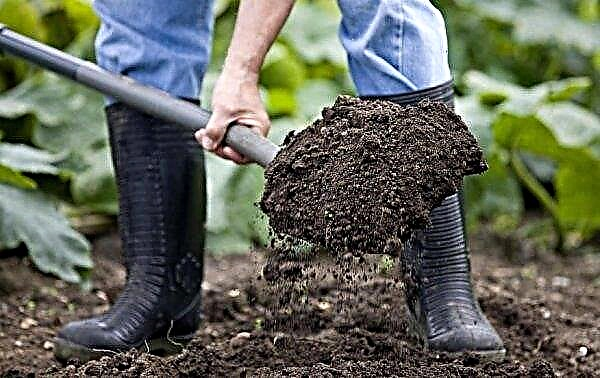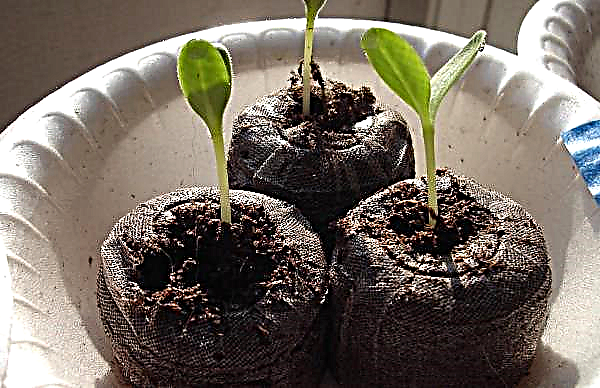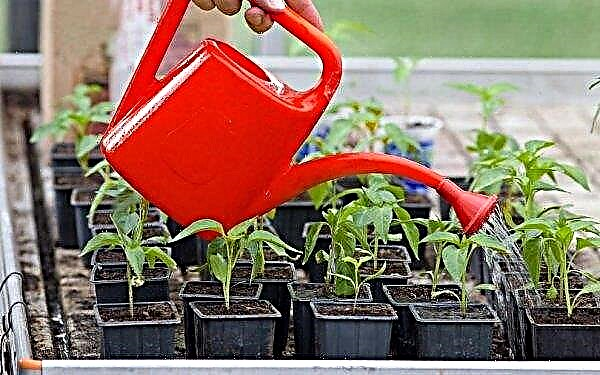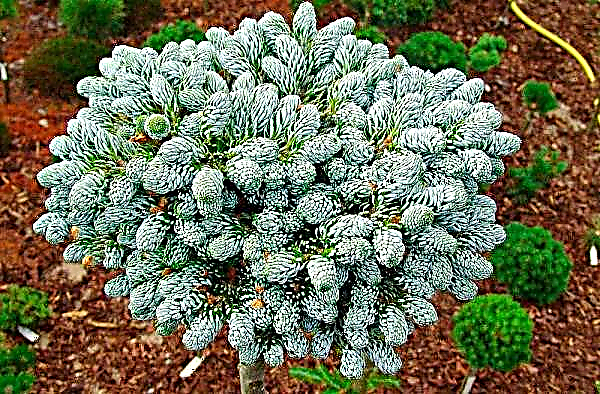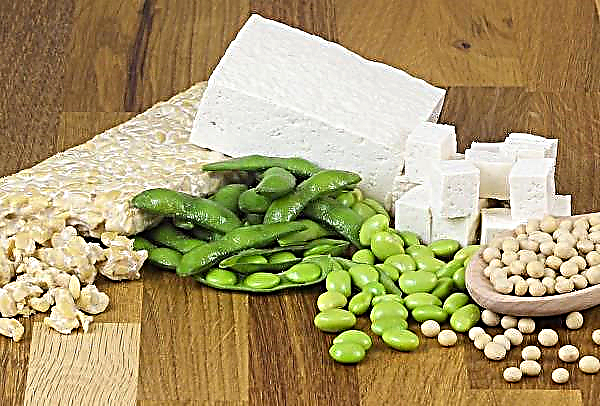Eggplant is often grown in private summer cottages for the preparation of delicious vegetable stews or preparations for the winter. Among all the varieties, the Bebo eggplant is especially notable, having a non-standard white color of the fruit, tasty and delicate pulp, as well as early harvest ripening. In the article, we consider the main characteristics of the Bebo variety, the characteristics of its planting and all the subtleties of growing a plant and caring for it.
Selection and botanical description of the culture
The described variety belongs to the hybrid and was obtained at the beginning of the XXI century in Holland. The breeding team of MONSANTO HOLLAND B.V.
They wanted to get a new eggplant variety that combines the good taste of vegetables, early ripening and the ability to adapt to adverse climatic conditions. On the territory of Russia eggplant Bibo began to be grown in 2008.Did you know? The Golden Eggs variety is the only type of eggplant that is grown exclusively as an ornamental indoor plant.
The main characteristics of the plant are presented below:
- The bushes have a small height - up to 85 cm. They are moderately sprawling and consist of several lilac-colored stems covered with fluffy leaves.
- The leaves of the plant are small, have slightly wavy edges. Painted in green.
- On the cups near the base of the fruit are frequent short spikes.
- The fruits have an elongated oval shape. Outside, vegetables are covered with a white matte skin.
- The length of the fruit is 18–20 cm, and the diameter can reach 8 cm.
- The variety is early ripe, harvesting can be done 85–90 days after the germination of seed material.
- The average weight of the fruit is about 210-300 g, on the bush all the eggplants are approximately the same size.
- The Bibo variety is highly germinated. Productivity can reach 4.8 kg per 1 sq. Km. m
- Vegetable pulp is white and juicy. It tastes great without unpleasant bitterness. Unlike other varieties, vegetables of this variety do not contain toxic solanine.
- Eggplant Bibo is resistant to fusarium and the tobacco mosaic virus, but can be attacked by the Colorado potato beetle.

Advantages and disadvantages
Eggplant Bibo has become a popular cultivar due to not only the non-standard color of the fruit, but also due to its many advantages that distinguish them from other varieties of vegetables.
- The advantages of the Bebo variety include:
- excellent yield;
- good taste;
- stable immunity to common infections and viruses;
- good presentation of the fruit;
- fast ripening vegetables;
- ability to adapt to various climate conditions;
- universality of cultivation (in open ground or in a greenhouse);
- good transportability;
- unpretentiousness in agricultural technology.
The disadvantages of the variety include the fact that only purchased seeds can be used for planting.
Important! If you take planting material from Bibo’s self-grown eggplants, the characteristics of the variety are not preserved.
How to grow seedlings on your own
For planting, it is recommended to use only seeds purchased from trusted sellers or in specialized stores. In southern regions with a warmer climate, Bibo eggplant seeds are sometimes immediately sown in open soil, but for the rest of the territory, it is best to first grow seedlings.
In open ground, planting material can be negatively affected by spring frosts, which will negatively affect germination.
Sowing time
Sowing seeds for seedlings is necessary so that by the time of transplanting to a permanent place of cultivation, several green leaves have managed to grow on it, but the sprouts are not too large.
Accordingly, the cultivation of eggplant seedlings Bibo begin in late February or early March. In this case, young sprouts can be planted in open ground around the end of April or early May, when the weather is stable and the probability of night frost disappears.
Did you know? Eggplant was only eaten in the 18th century. — Until that time, it was used for decorative and medicinal purposes.
The soil
In order for the Bibo eggplant seeds to receive all the necessary useful elements for growth, it is recommended to plant them in a nutritious and loose soil.
It can be bought in specialized stores or prepared independently from the following components:
- chernozem - 50%;
- peat - 25%;
- sand - 25%.
Before planting the seeds, it is recommended that the soil be thoroughly calcined in the oven for disinfection. Then, containers for seedlings are filled with this mixture and the soil is watered so that it is saturated with moisture and the donkey.
Capacity for growing
Bibo seedlings are grown in small individual containers filled with soil. It is not recommended to use a common container for growing several seedlings in it, since in this case young plants will need to be dived, and this procedure is poorly tolerated by eggplant of the indicated variety.
If you still grow sprouts in one common box, then they need to be picked very carefully, keeping the earthen lump formed around the roots of the sprout.
As an individual container for sprouts, you can use:
- peat cups;
- small wooden crates;
- small plastic containers;
- "Diapers" from plastic bags.
At the same time, the volume of the container for the sprout of eggplant seedling Bibo should be at least 400 ml.
Seed preparation
Before sowing seeds for seedlings, you must carefully read the instructions on the packaging. If it is indicated there that the seed has passed the necessary processing, then you can immediately begin to sow it. But it also happens that the purchased seeds are not processed by the producer, so their preparation must be carried out independently.

The process of preparing Bebobo eggplant seeds for planting consists of these important steps:
- Quality checking. Planting material is placed in a glass with clean water. After 20-25 minutes, low-quality seeds float to the surface - they need to be rejected.
- Sterilization. Seeds for 15 minutes are immersed in a 1% solution of potassium permanganate in order to get rid of possible infections. After sterilization, the seeds are washed well with water.
- Growth stimulator. Germination of eggplant seeds Bibo is very high, so this stage of preparation is not required. But if you wish, you can soak the planting material in a solution of a growth stimulator for 10 hours, so that it sprouts faster.
- Drying out. After all the procedures described, planting material is laid out on a paper towel and dried for 1-2 hours at room temperature.
Sowing seeds
After you have completed all the procedures for preparing the soil and planting material, you can start planting seeds. This process does not require special knowledge; it is enough to follow standard recommendations.
Step-by-step instructions for sowing Bibo eggplant seeds for seedlings are presented below:Important! Water the planted seeds with a small amount of water, gently spraying it above the surface of the soil.
- Make small indentations in the ground. If one common box is selected for sowing seedlings, then the distance between adjacent recesses should be at least 5 cm.
- Submerge the seeds in the prepared recesses by 1.5–2 cm.
- Sprinkle planting material with loose earth.
- Cover the container with seeds with a film and put in a well-lit warm place (at least + 22 ° С).
- If necessary, lightly irrigate the soil in containers with planted seeds. Under such conditions, green seedlings appear after 1-1.5 weeks.

Seedling Care
Usually seed sprouts appear in early March, when it is still cold outside and the daylight hours are not long enough, so young seedlings need to provide good lighting and grow them in a warm room.
The main features of the care for eggplant seedlings Bibo are presented below:
- after the main part of the seeds has sprouted, in a room with seedlings for several days you need to maintain a temperature of about +18 ° C. Then the seedlings are grown at ordinary room temperature;
- for better growth, seedlings are placed in a well-lit place, and when it gets dark outside - include phytolamps for artificial lighting;
- you can not put containers with seedlings in a draft - this will destroy the young sprouts;
- if the seeds were planted in a common container, then after the appearance of a pair of leaves on the shoots, the seedlings are picked into individual containers, while maintaining an earthen lump around the roots;
- for normal growth, after the appearance of 2-3 green leaves on the sprouts, nitrogen-containing and potassium fertilizers are introduced, stimulating the growth of green mass;
- 7-12 days before the planned transplantation, top dressing, consisting of phosphorus and potassium, is again introduced into the open ground;
- Sprouts are irrigated only under the root every 5–7 days. For the procedure, warm water is used with a temperature of +22 ... + 24 ° С.
Seedling hardening
To better eggplant seedlings Bibo transferred the transplant to the open ground, it is recommended to harden young plants. You need to start this procedure about a week before the planned planting of the sprouts in a permanent place, when the seedlings are already well grown and matured.
For hardening, containers with seedlings are taken out onto the street. In the early days, leave it in the open air for no more than 20-30 minutes. Gradually, this time is increased, bringing it to several hours by the end of the week.
Planting seedlings in a permanent place
Eggplant Bibo can be grown in open ground or in greenhouses. The second option is less common, as it requires a spacious greenhouse. For transplanting seedlings into the greenhouse, it is necessary that the shoots are old enough and have at least 7 green leaves.
In the greenhouse itself, the temperature during the day should be +24 ... + 28 ° С, and at night - at least + 20 ° С. But most often the seedlings of the described variety are transplanted directly into the open ground: a detailed description of this process will be discussed later in the article.
Optimal timing
Depending on the region of cultivation, the transplantation of eggplant sprouts Bibo can be carried out in the first half of May or early June. Seedlings at the time of transplantation should be sufficiently strong and have 5-6 green leaves. Usually sprouts reach these values at the age of 2 months.
Did you know? From the point of view of science, eggplant refers to berries, but in everyday life it is called a vegetable.
When transplanting, it is necessary to take into account climatic conditions so that the sprouts do not undergo night frosts that can destroy young plants. It is possible to plant eggplant seedlings in open ground only after it warms up sufficiently to a depth of about 10-12 cm.
The soil temperature should be at least + 14 ° C at an air temperature of about + 20 ° C. It is recommended to transplant seedlings in cloudy weather so that the bright sun does not destroy young plants.
Seat selection and crop rotation
For growing eggplant Bibo, you need to choose a suitable plot of the garden. Its preparation should be started in advance so that the plants grow in nutritious soil and give a rich harvest.

The basic requirements for the Bibo eggplant sector are:
- vegetables require a lot of space for growth, so the site for them should be quite spacious and large. For 1 square. m of space can accommodate no more than 6 bushes;
- plants are not recommended to be planted in heavy soil - the earth should be light and loose, it must pass water and air well;
- the selected area should be well lit by the sun - eggplants will not yield a plentiful crop if they grow in the shade;
- you can not plant plants in a draft or in a place blown by the wind - this can lead to the emergence of diseases of the bushes and poorly affect the yield;
- plants do not respond well to excessive soil moisture, therefore, for planting, you can not choose a site with a high level of groundwater;
- the soil on the site should be nutritious - for this purpose, in the autumn, organic fertilizers are applied from manure or compost in an amount of at least 1 bucket per 1 sq. km. m;
- legumes, potatoes or greens (spinach, lettuce, basil) can be planted next to the beds of eggplant;
- bad predecessors for vegetables of the Bebo variety are considered tomatoes, potatoes and zucchini;
- it is recommended to plant eggplants in areas where carrots, beets, greens, grains, legumes or melons were grown last year;
- next time you can plant eggplants in the same place only after 3-4 years.
Scheme and depth of landing
Typically, on a plot of eggplant Bibo planted in rows. At least 35 cm should remain between the bushes in the same row, and it is recommended to maintain an interval of 60–65 cm between the rows themselves.
Important! If eggplants are placed too close to each other, this will lead to a significant decrease in yield.
A step-by-step instruction for transplanting eggplant seedlings of Bibo into the open ground is presented below:
- Dig in the hole section with a depth of 10-15 cm, placing them according to the scheme described above.
- Pour 200–250 ml of warm water or an aqueous mullein solution onto the bottom of each well;
- Carefully remove the young sprout from the individual container with the earthen lump and place it in the hole.
- Sprinkle the eggplant roots with loose earth, pour a little seedlings with warm water.
- Mulch the soil around the young plant with straw.
Further care
After young plants have adapted to growing conditions in the open field, they need to provide further care. The cultivation of the Bibo variety is no different from the cultivation of any other eggplant variety: for good yield, it is enough to properly water the bushes, apply fertilizers in a timely manner and monitor the condition of the soil around the plants.
The cultivation of the Bibo variety is no different from the cultivation of any other eggplant variety: for good yield, it is enough to properly water the bushes, apply fertilizers in a timely manner and monitor the condition of the soil around the plants.
Watering
Eggplant Bibo needs a lot of moisture for normal growth. But watering should be moderate, as the plants react poorly to waterlogged soil.
The main recommendations for watering eggplant are described below:
- watering the bushes is recommended with an interval of 5-7 days;
- the earth around the plants should always be moist, but not sour;
- watering is carried out under the root, so that water does not fall on the leaves of the plant;
- in order to retain moisture in the soil near the roots of the bushes longer, the soil on the beds is covered with small peat or humus after each watering.
Fertilizer application
Eggplant Bibo needs a lot of nutrients that they can only get from the soil. Therefore, in addition to fertilizing the land on the site before planting, you need to periodically make additional fertilizing during plant growth. This is best done by combining with watering the bushes so that nutrients reach the roots of the plant faster.

The basic rules for fertilizing eggplant Bibo are described below:
- 10-14 days after the seedlings are transplanted into the open ground, they are fertilized with a complex containing nitrogen, potassium and phosphorus to stimulate the growth of the stem and leaves;
- a few days before the start of flowering, phosphorus-potassium top dressing is applied, which contributes to plentiful flowering and the formation of a large number of ovaries;
- at the stage of pouring the ovaries, the bushes are again fertilized with preparations containing potassium, phosphorus and a small amount of nitrogen to stimulate the growth and good taste of the fruits;
- after the first eggplants are collected, the plant needs to be fed again with phosphorus-potassium fertilizers to give it strength for further fruiting.
Soil care
It is equally important to provide quality soil care around the eggplant. Not only the quantity and quality of the future crop, but also the health of all vegetable crops that are grown around it depends on this.
Did you know? The ancient Greeks believed that the frequent use of eggplant in food leads to insanity and even called this vegetable "rabies apple."
The rules for soil care around the Bibo eggplant are described below:
- during the period of growth, flowering and fruit formation, all weeds around the bushes should be removed so that they do not draw all moisture and nutrients from the soil;
- if a dense crust has formed around plants on the surface of the soil, then it must be eliminated and the soil loosened carefully. This procedure improves the breathability of the soil, ensures that water gets directly to the roots of the plant;
- it is recommended to mulch the soil on an eggplant bed with shredded straw or humus in order to keep it loose and moist longer.
Preventative treatment
The Bibo eggplant variety is highly resistant to diseases and pests. If you strictly follow all the rules for planting and care described above, then these plants are not afraid of infection.

General measures for the prevention of diseases such as blackleg and late blight are described below:
- proper watering of plants;
- loosening of soil around the bushes;
- deep digging of a site in the fall and before landing;
- disinfection of planting material.
The green leaves of the bushes often attract a large number of Colorado potato beetles, which can destroy plants even before flowering. To combat these insects, various chemical insecticides are used - they can accumulate in the soil and fruits.
To prevent the appearance of the Colorado potato beetle in the area with eggplant, the most reasonable way is to carry out the prevention:Important! It is not recommended to overexpose ripened vegetables on the bush, as their taste deteriorates and the seeds become coarser.
- treat seedlings with chemical preparations from pests (for example, with Prestige);
- plant marigold or marigolds along the perimeter of the site with eggplant - their aroma repels insects;
- inspect plant leaves - if eggs or larvae of the Colorado potato beetle are found, then they are collected manually;
- plant eggplants in plastic bottles - this container has a smooth surface on which insects can not get to the leaves of the bush.
Harvesting
Harvested ripened eggplant Bibo is usually harvested in the second half of August and early September. Ripe fruits are harvested as they grow — approximately every 10 days. At the same time, vegetables are medium in size, their flesh is the most tender and delicious, contains only small seeds.

When harvesting, ripe eggplant must be carefully separated from the bush using a secateurs. An incision is made on the strong leg of the fetus, 4-5 cm from the calyx. Fresh fruits can be stored for a month in a cool and dark place at a temperature of about +2 ... + 5 ° С and air humidity of 80%.
Eggplant Bibo is characterized by excellent taste, there is no unpleasant bitterness in them, therefore they are actively used in cooking:
- fresh for the preparation of vegetable salads;
- for cooking stewed vegetable stews;
- for frying or baking in the oven;
- for the preparation of delicious canned preparations for the winter.
Eggplant Bibo will surely please the gardener with a beautiful appearance and size of the fruit, and their taste will allow you to cook from these vegetables a variety of dishes for every taste. To get a plentiful harvest of fruits, plants do not need specific care - it is enough to follow the recommendations and rules that were considered in our article.



